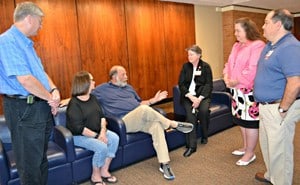‘Perfect Storm’ Saves Life of UAMS Faculty Member
| The first person to see Paul Thaxton slumped in a chair in the lobby of the Administration West building initially thought he was asleep.

When Paul Thaxton (seated) had a cardiac arrest, coming to his rescue were (from left) physician assistant faculty members Nadja Button and Theresa Morris as well as Department of Emergency Medical Sciences faculty and trained paramedics Harold Shray and Tim Rinehart.
Thaxton, division director for the Nuclear Medicine Imaging Sciences program in the College of Health Professions, had not fallen asleep while waiting on his ride home that February afternoon. He was having a cardiac arrest, but thanks to employees in the building, the quick response of faculty from the physician assistant and emergency medical sciences programs and the presence of an automated external defibrillator, Thaxton was revived and is back on the job.
“You often hear the term ‘perfect storm’ in a negative context, but in this case it was a combination of several factors that was a good thing: people nearby who called 911, trained responders who were close and the AED,” said Nadja Vawryk Button, M.H.S., an assistant professor in the Department of Physician Assistant Studies.
Button and colleague Theresa Morris, M.P.A.S., PA-C, the director of clinical education for the physician assistant program, were in a meeting in a nearby building when summoned to come for someone who needed help. Not sure what they would find, they arrived to find the unconscious Thaxton had been moved to the floor, where Morris discovered he had no pulse, so she and Button began CPR.
“I recognized Paul instantly and it flashed through my mind – ‘I just saw you at a faculty gathering last week,” Morris said.
Next to arrive were Tim Rinehart, M.Ed.., and Harold Shray, M.S.O.M., paramedics and faculty members in the Department of Emergency Sciences. They brought the AED.
“Honestly, it looked grim when we got there, but when the AED was attached and it said ‘shock advised’ just like we train our responders to look for, it gave me hope,” Rinehart said.

Thaxton (seated) and his wife Pam (seated to his left) recount the day of his cardiac arrest with Rinehart, Morris, Button and Shray in the lobby where it all took place.
For each minute that passes before defibrillation therapy and CPR is administered, a victim’s survival odds decrease by roughly 10 percent, according to one study. Rinehart and Shray used the device to administer two electric shocks that helped reestablish a pulse. The ambulance soon arrived, taking Thaxton to the hospital.
It was two days later when he awoke, not remembering anything about what had happened. His sudden cardiac arrest had no warning signs, Thaxton said. He had a heart attack about 15 years ago while working too long in the summer heat.
“I didn’t know who had come and treated me at the time. I have since thanked them, both for myself and on behalf of my family,” said the husband and father of two grown children.
Thaxton returned to work part time about a month following the incident. He’s now working full time again.
The AED the two faculty members brought with them that day was one in the Emergency Medical Sciences offices. But when Thaxton and the group of responders gathered recently for a photo, they noted that there was actually one of the devices in the building, located on the second floor.
Five AEDs were donated to the college in 2012 by Ben Wellons and his company eMed Healthcare of Little Rock. The devices were placed around the college’s buildings.
“I think the presence of the AEDs has made our campus a safer place and we continue to be thankful for eMed’s donation,” said Dean Douglas Murphy, Ph.D. “We are so glad Paul is doing so well and his fellow UAMS employees and faculty colleagues were there that day to respond as they did.
“I think this situation demonstrates the lifesaving difference these devices can make in starting treatment before the ambulance arrives.”
Added Button, the PA faculty member: “Even if you don’t know if it will be needed but you know one of these devices is nearby — bring it because you never know.”
Morris noted the incident was her first out of hospital emergency response and the first time she was one of the first responders on the scene. “As we teach our students, perfect the basics to create a good foundation for your training,” she said.
Nearby Shray noted that Morris and Button had “a good rate” of CPR compressions going when he and Rinehart arrived.
Thaxton sitting in the same blue chair — he noted it was a while before he could go near that chair — asked which of the faculty members handled the chest compressions. “You did a good job. I was sore for two weeks,” he said.